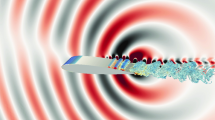Abstract
The flow field passing through a highly loaded low pressure (LP) turbine cascade is numerically investigated at design and off-design conditions. The Field Operation And Manipulation (OpenFOAM) platform is used as the computational Fluid Dynamics (CFD) tool. In this regard, the influences of grid resolution on the results of k-ε, k-ω, and large-eddy simulation (LES) turbulence models are investigated and compared with those of experimental measurements. A numerical pressure undershoot is appeared near the end of blade pressure surface which is sensitive to grid resolution and flow turbulence modeling. The LES model is able to resolve separation on both coarse and fine grid resolutions. In addition, the off-design flow condition is modeled by negative and positive inflow incidence angles. The numerical experiments show that a separation bubble generated on blade pressure side is predicted by LES. The total pressure drop has also been calculated at incidence angles between -20° and +8°. The minimum total pressure drop is obtained by k-ω and LES at design point.
Similar content being viewed by others
References
H.P. Hodson and R.J. Howell, Bladerow interactions, transition, and high-lift aerofoils in low-pressure turbines, Annu. Rev. Fluid Mech., 2005, Vol. 37, P. 71–98.
H.P. Hodson and R.G. Dominy, The off-design performance of a low-pressure turbine cascade, ASME J. Turbomach., 1987, Vol. 109, P. 201–209.
R. Stieger and H.P. Hodson, The unsteady development of a turbulent wake through a downstream low-pressure turbine blade passage, ASME J. Turbomach., 2004, Vol. 126, No. 4, P. 536–543.
R. Stieger and H.P. Hodson, The unsteady development of a turbulent wake through a downstream low-pressure turbine blade passage, ASME J. Turbomach., 2005, Vol. 127, No. 2, P. 388–394.
M.M. Opoka, R.L. Thomas, and H.P. Hodson, Boundary layer transition on the high lift T106A low-pressure turbine blade with an oscillating downstream pressure field, ASME J. Turbomach., 2008, Vol. 130, No. 2, P. 021009-1–021009-10.
X. Wu and P.A. Durbin, Evidence of longitudinal vortices evolved from distorted wakes in a turbine passage, J. Fluid Mech., 2001, Vol. 446, P. 199–228.
V. Michelassi, J.G. Wissink, J. Fröhlich, and W. Rodi, Large-eddy simulation of flow around low-pressure turbine blade with incoming wakes, AIAA J., 2003, Vol. 41, No. 11, P. 2143–2156.
K. Lodefier and E. Dick, Modelling of unsteady transition in low-pressure turbine blade flows with two dynamic intermittency equations, J. Flow, Turbulence and Combustion, 2005, Vol. 76, No. 2, P. 103–132.
J.G. Wissink, W. Rodi, and H.P. Hodson, The influence of disturbances carried by periodically incoming wakes on the separating flow around a turbine blade, J. Heat and Fluid Flow, 2006, Vol. 27, No. 4, P. 721–729.
K. Matsuura and C. Kat, Large-eddy simulation of compressible transitional flows in a low-pressure turbine cascade. AIAA J., 2007, Vol. 45, No. 2, P. 442–457.
C. Velez, P. Coronado, H. Al-Kuran, and M. Ilie, Numerical computations of turbine blade aerodynamics; comparison of LES, SAS, SST, SA, and k-ε. AIAA/ASME/SAE/ASEE Joint Propulsion Conference & Exhibit, 2011.
A. Ghidoni, A. Colombo, S. Rebay, and F. Bassi, Simulation of the transitional flow in a low pressure gas turbine cascade with a high-order discontinuous galerkin method, ASME J. Fluids Engng, 2013, Vol. 135, No. 7, P. 071101-1–071101-8.
L. Fottner, Test cases for computation of internal flows in aero engine components, AGARD-AR-275, 1990, P. 112–123.
T. Hildebrandt and L. Fottner, A numerical study of the influence of grid refinement and turbulence modeling on the flow field inside a highly loaded turbine cascade, ASME J. Turbomach., 1999, Vol. 121, No. 4, P. 709–716.
The Open Source CFD Toolbox, User Guide, OpenCFD Ltd. 2014, URL http://www.openfoam.org/docs/user/.
URL http://www.openfoam.org.
D.C. Wilcox, Turbulence Modeling for CFD, 3rd ed. DCW Industries, Inc. 2006, 522 p.
B.E. Launder and D.B. Spalding, The numerical computation of turbulent flows, J. Comput. Methods in Appl. Mech. and Engng, 1974, Vol. 3, No. 2, P. 269–289.
A. Leonard, Energy cascade in large-eddy simulations of turbulent fluid flows, Advances in Geophysics, 1975, Vol. 18, P. 237–248.
P.R. Spalart and S.R. Allmaras, A one equation turbulence model for aerodynamic flows, Recherche Aerospatiale, 1994, Vol. 1, P. 5–21.
R.D. Stieger, D. Hollis, and H.P. Hodson, Unsteady surface pressures due to wake-induced transition in a laminar separation bubble on a low-pressure cascade, ASME J. Turbomach., 2004, Vol. 126, No. 4, P. 544–550.
P.D.L. Calzada and A. Alonso, Numerical investigation of heat transfer in turbine cascades with separated flows, ASME J. Turbomachinery, 2003, Vol. 125, No. 2, P. 260–266.
A. Duden, I. Raab, and L. Fottner, Controlling the secondary flow in a turbine cascade by three-dimensional airfoil design and endwall contouring, ASME J. Turbomach., 1999, Vol. 121, No. 2, P. 191–199.
Author information
Authors and Affiliations
Corresponding author
Rights and permissions
About this article
Cite this article
Vakilipour, S., Habibnia, M., Sabour, M.H. et al. Surface pressure characteristics of a highly loaded turbine blade at design and off-design conditions; a CFD methodology. Thermophys. Aeromech. 24, 469–482 (2017). https://doi.org/10.1134/S0869864317030143
Received:
Revised:
Published:
Issue Date:
DOI: https://doi.org/10.1134/S0869864317030143




